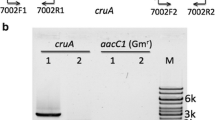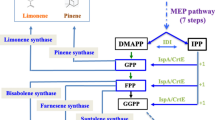Abstract
During cultivation under storage conditions with BG11 medium containing acetate as a carbon source, Synechocystis sp. PCC6803 accumulated poly(3-hydroxybutyrate) up to 10% (w/w) of the cell dry weight. Our analysis of the complete Synechocystis sp. PCC6803 genome sequence, which had recently become available, revealed that not only the open reading frame slr1830 (which was designated as phaC) but also the open reading frame slr1829, which is located colinear and upstream of phaC, most probably represent a polyhydroxyalkanoic acid (PHA) synthase gene. The open reading frame slr1829 was therefore designated as phaE. The phaE and phaC gene products exhibited striking sequence similarities to the corresponding PHA synthase subunits PhaE and PhaC of Thiocystis violacea, Chromatium vinosum, and Thiocapsa pfennigii. The Synechocystis sp. PCC6803 genes were cloned using PCR and were heterologously expressed in Escherichia coli and in Alcaligenes eutrophus. Only coexpression of phaE and phaC partially restored the ability to accumulate poly(3-hydroxybutyrate) in the PHA-negative mutant A. eutrophus PHB–4. These results confirmed our hypothesis that coexpression of the two genes is necessary for the synthesis of a functionally active Synechocystis sp. PCC6803 PHA synthase. PHA granules were detected by electron microscopy in these cells, and the PHA-granule-associated proteins were studied. Western blot analysis of Synechocystis sp. PCC6803 crude cellular extracts and of granule-associated proteins employing antibodies raised against the PHA synthases of A. eutrophus (PhaC) and of C. vinosum (PhaE and PhaC) revealed no immunoreaction.
Similar content being viewed by others
Author information
Authors and Affiliations
Additional information
Received: 11 March 1998 / Accepted: 2 June 1998
Rights and permissions
About this article
Cite this article
Hein, S., Tran, H. & Steinbüchel, A. Synechocystis sp. PCC6803 possesses a two-component polyhydroxyalkanoic acid synthase similar to that of anoxygenic purple sulfur bacteria. Arch Microbiol 170, 162–170 (1998). https://doi.org/10.1007/s002030050629
Issue Date:
DOI: https://doi.org/10.1007/s002030050629




